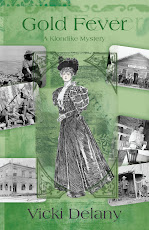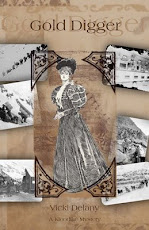

With the publication of Gold Web, the fourth book in the Klondike Gold Rush series only two months away, I’m mentally back in the Klondike.
Today, I’m going to recommend some books that I used as research for the history of the time. The definitive book on the subject is Pierre Berton’s Klondike: The Last Great Gold Rush. A highly readable popular-history book, it’s well worth starting your historical investigation with. One thing about Berton though, is that he does gloss over women’s participation. (Hardly the first historical record to do so). It’s estimated that about one-sixth of the people who went to the Klondike were women. And not just prostitutes and dance hall owners either. But businesswomen, shopkeepers, nurses, nuns, newspaper reporters, wives and mothers. They carried their babies up the Chilkoot trail or lugged pregnant bellies and tried to make homes out of the wilderness and created successful (or not-so-successful) businesses. They supported themselves, or they supported their families.

Charlotte Gray’s book: Gold Diggers: Striking it Rich in the Klondike, examines, among others, Belinda Mulrooney, prominent businesswoman.
I’d recommend Also Gamblers and Dreamers: Women, Men, and Community in the Klondike. by Charlene Porsild
And Goodtime Girls of the Alaska-Yukon Gold Rush by Lael Morgan for a peek into the demimonde.
And now, a word from our sponsor: Pre-orders are important to build interest in a book (and usually at a reduced price) Gold Web is available for Pre-Order at a reduced price.
From Amazon.ca, From Amazon.com, From Chapters/Indigo. Also your favourite independent bookstore.
















